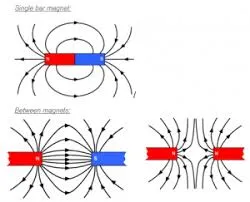Escape the Solar Wind
Hang a bar magnet on a piece of thread and wait until it stops moving. One end will eventually point to the north pole of the Earth. This happens because the earth is a giant magnet, and your magnet is lining up with the Earth's magnetic field, which surrounds our planet like a giant bubble and allows us to find our way around.
A magnetic field is an invisible force field that surrounds magnets. Other magnets and some metals are influenced if they come into the magnetic field. The magnetic field around a bar magnet is called a butterfly diagram. Perhaps you can see why. The field is why a magnet will stick to a fridge, or two magnets may push each other away. Each magnet’s magnetic field interacts with the other’s, causing attraction or repulsion.
The ends of a magnet are called poles. One end is called the north-seeking pole, and the other is the south-seeking pole. We usually shorten these to north and south. Put two poles that are the same together; they will repel. A north and a south pole attract. You can try this with two magnets to feel the forces pushing the magnets apart or pulling them together.
Compasses use the tendency of one end of a magnet to point north. A compass needle is a tiny magnet that can spin freely. It lines up with the Earth's magnetic field, pointing north and south. Very useful for finding your way. The Earth behaves as if it has a giant magnet stuck through it. For your compass to line up the way it does, the Earth’s south magnetic pole is in the north, and its magnetic north is in the south.
The Earth’s magnetic field isn’t just helpful in finding your way around; it also protects us from the solar wind, a stream of charged particles constantly thrown out from the sun. These particles have a lot of energy and would harm life and remove the atmosphere without our magnetic shield.
Why does the earth have a magnetic field? If you cut the earth in half, you will see that it is made up of layers. You can see these in the diagram.
It is the earth's core that makes the magnetic field. The core has two layers: the inner core and the outer core. The inner core is solid and made from nickel and iron. It lets out heat because it contains radioactive substances. These have let out energy over millions of years.
The outer core is liquid nickel and iron so it can move around. The heat from the inner core causes this movement the same way water moves when you heat it in a pan. These movements are called convection currents. How does this turn the Earth into a magnet? Moving metals, like those in the core, produce electric currents, and driving electric currents create magnetic fields.
The earth's magnetic field is big enough to surround the Earth and reaches into space for tens of thousands of kilometres. The solar wind's charged particles can’t get into it, so we are protected. We are fortunate to have a liquid core on Earth; other planets in the solar system have lost theirs, making them hostile to life. It’s not just the radiation from the sun that’s the problem; the solar wind is blowing their atmospheres off into space.
Mars is a planet that people are hoping to visit one day. On the journey there, astronauts must be protected from the solar wind so they don't become ill. They will also need to be protected once they reach Mars because the red planet has lost its magnetic field. This happened because Mars is smaller than the earth, so it cooled down much faster. Its core has lost enough heat to turn solid, so it can no longer move. Without movement, it can't generate a magnetic field, so the surface of Mars is exposed to deadly particles from the sun. Mars' atmosphere is being blown away by the solar wind, too, leaving even less protection. Earth is a safe place to live and has a thick atmosphere because of magnetism.
To travel to Mars and live there, people must take air, food, building materials and protection from radiation. Scientists are trying to find ways to do all of this. It is a complex problem to solve because Mars is far away, about three hundred million miles, and it will take about seven months to get there; perhaps you could be part of a team that solves all of the problems and lands the first people on the Red Planet.









Comments
Post a Comment